| 1 | Ontario’s dangerous rattlesnake |
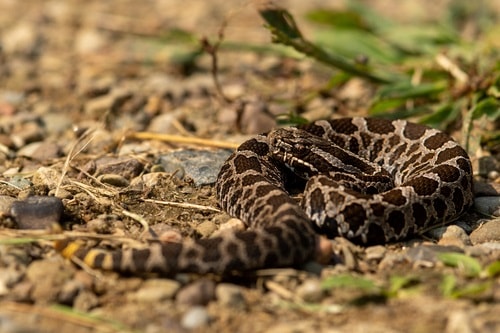
Canada is far from a hotbed of venomous snakes, yet the country still contains three. Pacific and prairie rattlesnakes live in the west, while the only venomous snake in eastern Canada is the endangered massasauga (Sistrurus catenatus). This is the most northeasterly rattlesnake of all, inhabiting the northeast US and Ontario. They share the usual vertical pupils, cytotoxic venom, and a piercing rattle to alert intruders to their presence.
While massasaugas are classed as a rattlesnake, they don’t belong to the main Crotalus rattlesnake family with 50+ members. Instead, they’re an offshoot branch of the evolutionary tree, part of the much smaller Sistrurus family with 3 members. This also contains the pygmy rattlesnake of Florida, and the western massasauga.
This is a relatively short species at an average of just 50-70cm. The longest eastern massasauga of all time measured 100.3cm, versus 189.2cm for a timber rattlesnake. The latter is the only rattlesnake the massasauga shares territory with, as other eastern US species like eastern diamondbacks and pygmy rattlesnakes live further south (Florida, Alabama, etc).
| 2 | Habitat: wetlands and riverside vegetation |
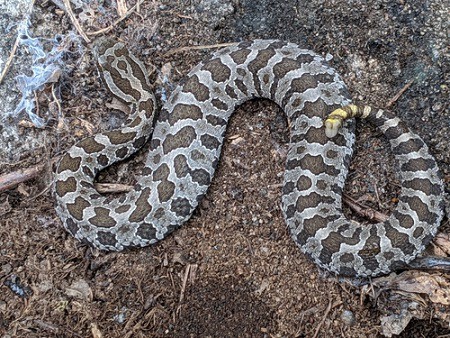
While timber rattlesnakes prefer forests with an abundance of fallen logs and branches, the massasauga is a creature of wet areas. You’re most likely to trip over a massasauga in swampland, marshland, by the moist shores of rivers and lakes, and in wet prairies. One of their folk names is swamp rattler, another is muck rattler. They’re often found lurking in dark crayfish burrows along river shores.
This more limited habitat means that massasaugas are in sharp decline. Their range is similar to 200 years ago – New York, Michigan, Pennsylvania, Ontario, etc. But those boundaries have been badly hollowed out. Within their territory, only fragmented and isolated pockets of massasaugas remain.
Culprits include the draining of wetlands to construct housing estates, and dividing pristine habitats with roads. Massasaugas are slow and deliberate creatures rather than energetic travellers, and splitting habitat prevents individual pockets from linking up. They have a great fear of human habitat – the greatest extent is one that ventured to an Ontario golf course in 2012, directly adjacent to Blind River. Michigan is the only US state where massasaugas aren’t listed as “endangered”.
| 3 | Rarely kills its victims |
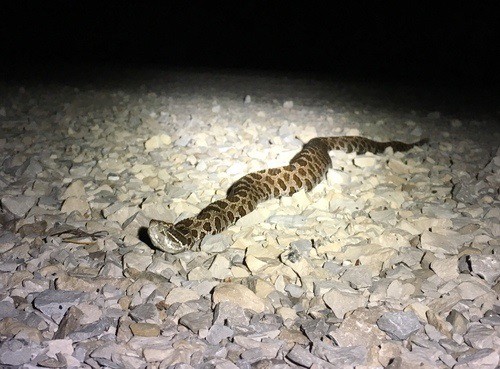
Massasaugas are one of the milder rattlesnakes of North America. Its raw venom has an LD50 score of 2.9mg, while the venom yield is similarly weak at 15-45mg per bite. An eastern diamondback can unleash a flood of 400mg per bite, and with a stronger LD50 score of 1.2mg. Timber rattlesnakes are intermediate, scoring 1.64mg with a yield per bite of 75-210mg. Eastern massasaugas also have relatively small fangs, and aren’t especially aggressive, preferring to flee into the undergrowth if possible. Unlike Mojave or tiger rattlesnakes, they lack any confirmed neurotoxic powers.
It’s estimated that no more than 3 people are bitten by massasaugas annually. The last confirmed death happened over 40 years ago. Just two deaths are known from Ontario.
Massasaugas are recognisable by eyemask or hourglass-shaped blotches, which are the densest black. On its flanks, the blotches are smaller, but just as tightly packed and vividly black. Overall, they have a blacker appearance than the timber rattlesnake from a distance.
| 4 | Survival strategies |
In Canada, massasaugas are active only from late April to October, due to cooler climates. While massasaugas aren’t especially energetic, their daily movements can pile up over the course of a year. One male massasauga travelled 4000 metres from the scientists’ initial capture point to its winter hibernation site. It’s been observed that massasaugas are more commonly found hunting where tree canopy cover is below 50%, and ground vegetation cover is above 60%.
Like timber rattlesnakes, massasaugas often hibernate communally. Up to ten have been found together in vacant crayfish or mammal burrows. Other sites include twisting root beds and rock fissures. These hibernation dens must be below the frost line, or the sheltering massasauga may freeze solid.
Instead of machinegunning baby vipers out every year, massasaugas reproduce relatively slowly. In Ontario, they produce biannually, and some mothers only triennially. Batches of fresh massasaugas typically contain 3-20. Newborns are 18-25.6cm long.
| 5 | Ontogenetic venom shift |
Massasauga venom is confirmed to transform with age. A 2022 study tested equal quantities of venom from Sistrurus catenatus of various ages: juvenile, subadult, and adult. The results clearly showed that juvenile venom had stronger haemorrhaging and proteolytic powers, but was less lethal.
They tested the minimum haemorrhagic dose (MHD), the lowest quantity of venom required to cause a haemorrhagic zone 10mm in diameter. The lower the score, the more powerful the venom. Juveniles achieved an MHD of 2.39 µg, versus 3.72µg for subadults and 4.52µg for adults. It was theorised that the haemorrhaging allows pre-digestion of prey, when their mouths can’t gape as widely.
Meanwhile, juvenile venom had an LD50 score of 2.5µg/g, measuring the quantity required to kill 50% of prey injected. Sub-adults were far lower at 0.81µg/g, while adults were the lowest at 0.7µg/g. As massasaugas age, their venom sheds any unnecessary trivialities and becomes a focussed elixir of assassination.
| 6 | Causes swelling and bruising |
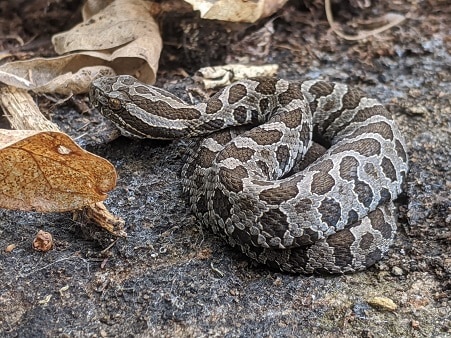
One detailed case study came from Ontario in 2018. A 25 year old man was wandering the east Georgia Bay, making the mistake of wearing sandals, when a hidden massasauga sank its fangs into his big toe. Symptoms rapidly appeared including a visibly swollen lower leg, and a haemorrhagic zone around the toe. He also had a nasty bruise (hematoma) near his groin, well away from the bite site, which covered 6-12cm. The man resisted visiting hospital until 22 hours post bite, when he finally gave in.
Blood testing revealed massive disruption of important clotting factors. The man’s fibrinogen was severely suppressed, at 0.6µmol/L versus a healthy range of 5.1-11.8. His partial thromboplastin time soared to 180 seconds, versus a standard range of 20-40s. Thromboplastin accelerates factor Xa, which itself accelerates the conversion of prothrombin to the clotting material thrombin.
The man rapidly received 10 vials of antivenom. Later, when his swelling and coagulopathy still hadn’t healed, he was given an extra 10 vials. All the blood markers suggested that spontaneous bleeding was imminent. Yet the patient experienced no haemorrhaging at all, possibly due to receiving 32 vials of antivenom over his hospital stay. At 40 hours post bite, the swelling had largely subsided. The man was discharged after 4 days, with no lasting effects.
| 7 | Haemorrhaging is rare |
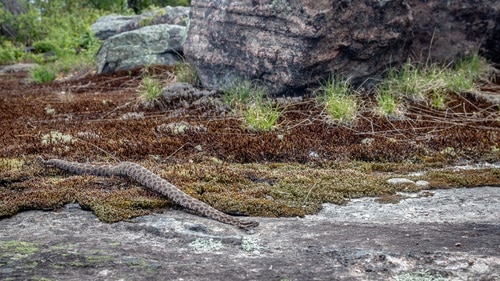
Sistrurus catenatus bites are easily survivable if you reach the emergency room rapidly, or even if you don’t. Other cases are very similar to the one above. A 62 year old man was bitten by a massasauga on the right thumb, causing his fibrinogen levels to plummet to 1.47 µmol/L, yet he experienced no excessive bleeding.
Another case happened in Frederic, Michigan, when children found a 30cm massasauga under a kayak at a campsite. A 56 year old man appeared and placed the massasauga in a coffee can using a stick. While showing off his prize to campsite residents, he was bitten on the left thumb. By 24 hours post bite, his hand was fully swollen, but there was no mention of haemorrhaging. Bruising spread all the way up his forearm by 96 hours. The man ultimately received 4 antivenom vials, and survived with ease, but experienced a feverish reaction to the antivenom serum.
The massasauga’s symptoms are fairly consistent: plenty of swelling and bruising, but little haemorrhaging or death (in humans anyway).
| 8 | Diet: nonstop small mammals |
The diet of the massasauga is well researched and the truth is clear: this snake is overwhelmingly a mammal hunter. Luckily, this tends to be small scurrying mammals rather than strange ape creatures that got lost and wandered out of Africa.
Firstly, we have a 2009 study, which combined samples from both Ohio and Ontario. In Ohio, mammals contributed 97.6% of the diet. In Ontario, mammals contributed 88%, as two snakes were also recorded. The most popular prey was identical between both populations: the northern short-tailed shrew (Blarina brevicauda). Massasaugas may be opportunistic based on location, but this is the meal they go to bed dreaming about each night. One surprising prey was the eastern chipmunk. Another study found an American red squirrel.
The second study was conducted in 2023, across 10 different massasauga populations in Michigan. Again, mammals utterly dominated. This time, northern short-tailed shrews were second most common, tied with masked shrews. The most popular prey was easily the meadow vole (Microtus pennsylvanicus). No massasaugas with a grotesque dog walker-shaped bulge were found. The study concluded that “small mammals are a crucial part of eastern massasauga rattlesnake diet“.
| 9 | Other dietary treats |
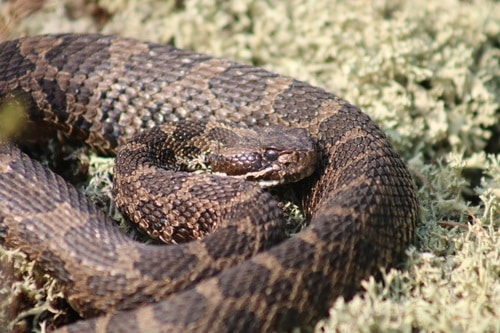
Snakes are occasionally chanced upon and gobbled up by the massasauga as well. Ther confirmed prey include…
Common garter snake – an ultra common species of rivers and marshes, Found in 47 of 48 lower US states. Slightly venomous.
Dekay’s brown snake – a harmless snake averaging at less than 30cm. Hides in well vegetated areas. Also confirmed prey for speckled kingsnakes.
Eastern massasauga – cannibalism was confirmed for this snake in a study conducted in southern Michigan.
Northern redbelly snake – part of the same Storeria family as Dekay’s brown snakes. Another harmless, shy snake that lurks under logs or rocks. Also confirmed prey for copperheads.
Smooth green snake – the king of camouflage. Harmless. Mainly inhabits moist grassy areas.
Feeding on snakes is very rare for a rattlesnake. The one species where they contribute a decent portion of calories is the Querétaro dusky rattlesnake of Mexico. Then again, massasaugas aren’t part of the main Crotalus family, and this one area where maybe they’re diverging. They’re also rumoured to feed on more amphibians than the average rattlesnake. This 2023 study found three records: two unidentified frogs and toads, and a red-backed salamander.
| 10 | The Sistrurus rattler family |
Massasaugas target their preferred prey, as the venom was proven in a 2008 study to be more lethal to mammals than lizards and frogs. Younglings also wield the dark art of caudal luring. Their rattle and lower tail is a bright sulphur yellow, which tricks local frogs into thinking they’ve found a tasty insect meal. A 1984 study on captive massasaugas observed them wiggle the tail in a mesmerising motion. The frogs drew closer in excitement, and bit down on the tail, which provided a signal for the massasaugas to turn around and eat them. In adulthood, this bright tail tip fades away.
In 2011, the massasauga was split into two species: the eastern massasauga (Sistrurus catenatus), which we’re talking about today, and the western massasauga (Sistrurus tergeminus). The latter is similar in its lifestyle and inhabits Texas, Oklahoma and Kansas, appearing only west of the Mississippi river. There’s also a subspecies of the western form called the desert massasauga (Sistrurus t. edwardsii).
According to one of the studies above, eastern massasaugas have the most mammal-dominant diet. Western massasaugas eat mammals with secondary helping of lizards, whereas desert massasaugas reverse this, with lizards first and mammals second, which makes sense in arid landscapes.